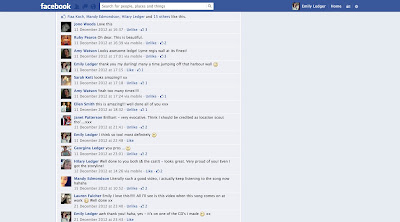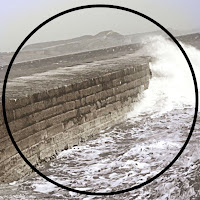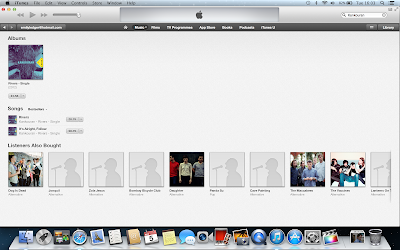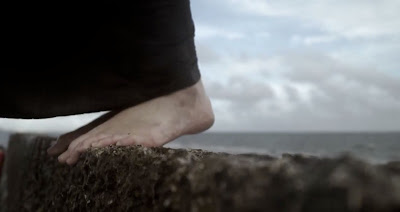HOW DID YOU USE MEDIA TECHNOLOGIES IN THE CONSTRUCTION AND RESEARCH, PLANNING AND EVALUATION STAGES?
I will divide this question into 4 sections, construction, research, planning and (ongoing) evaluation.
RESEARCH
The internet is a fantastic device making research much more enjoyable and efficient. It enables you to access information from all over the world, within seconds. Due to the type of research I was doing - into British bands and an African Dance tribe/group I needed access to many different websites and varieties of opinions and the origins of the dance.
Part of the brief was to find a British unsigned band, usually meaning visiting websites such as YouTube, Sound Cloud and Spotify. However, I was confident that my music variety was wide enough to find a British unsigned band that no one else would be using. After narrowing down a choice of three, I chose a band called 'Kankouran'. I originally found their music via an advert for E4's programme Skins series 6 (the YouTube clip) The song is called 'Rivers'.
Research is a large part of getting the music video and promotional package to be in sync with each other. Without the correct research you may be targeting the wrong group of people creating an image which does not fit into the right genre for the chosen artist, emphasising the importance of getting to know the genre you will be working closely with when going through the processes to complete A2. From this, I looked at what aspects of the band I wanted to find out more about. Not knowing what the name meant, I chose this to research. I used the internet, in particular google, to reach Kankouran, I listened to their music via YouTube, Sound Cloud and Spotify; a free music player. The band make themselves accessible online to their audience, which is clever as they are using the right techniques to target a somewhat niche audience.
After researching 'Kankouran', the genre of the chosen artist is also important. First of all I researched the band's influences to try to deduce what genre they would fit into. From the list of bands and artists that have inspired them, indie/electro/rock is what they would be stratified into, listening back to the track you can definitely detect some aspects of songs from other artists.
Research is a large part of getting the music video and promotional package to be in sync with each other. Without the correct research you may be targeting the wrong group of people creating an image which does not fit into the right genre for the chosen artist, emphasising the importance of getting to know the genre you will be working closely with when going through the processes to complete A2. From this, I looked at what aspects of the band I wanted to find out more about. Not knowing what the name meant, I chose this to research. I used the internet, in particular google, to reach Kankouran, I listened to their music via YouTube, Sound Cloud and Spotify; a free music player. The band make themselves accessible online to their audience, which is clever as they are using the right techniques to target a somewhat niche audience.
 |
| Spotify |
 |
| YouTube |
 |
| SoundCloud |
When I had researched each genre individually and summed up in conclusion about them, I started to do some research into similar bands to Kankouran. By searching the name and songs of Kankouran into Spotify and YouTube, it brings you related artists, it means you can explore music within the same genre looking for similar artists. Some of Kankouran's related artists were, Lucy Rose, Rams' Pocket Radio, James Vincent McMorrow and The Verve.
This allowed me to associate Kankouran with other bands, not to let them stand alone in my research.
Post production I wanted to see if my music video had the appeal of the audience, I used Facebook; instantly sharing with 350 people. Twitter; sharing with 170 people, thanks to the internet I was able to do. I received great feedback comments on my music video and was pleased with the outcome. "looks awesome", "this is beautiful", "love this!", "looks amazing", "Brilliant - very evocative" were just some of the comments that people had posted, from all different ages, not just the target audience, some were my Mother's age and giving me feedback. I had not planned for this demographic to be viewing the video. I also learnt that 18 people 'liked' the video, 1 person 'shared' the video and from that 1 share, received 6 more 'likes' on it.
 |
| Some of the Facebook feedback |
It was also about how to challenge the generic conventions of Indie digi-packs.
PLANNING
Going down to devon to shoot a music video in a week was always going to be a risk, but by keeping in constant contact with teachers and of course, using the internet to do so, made it possible to know whether we needed to re-shoot a scene or not. Before we went down, we planned exactly where we were going to be filming and when, keeping in sync with the weather forecast. The internet meant I was able to receive feedback from experienced people on the other side of the country, which ultimately meant it was like having a teacher on location with me whilst filming.
The exposure of the Indie genre is bigger now than it has ever been before, but this does not mean it is still easily accessible. There are online magazines, and radio channels that I often kept up with to keep in check with what was going on in the indie-music scene. www.nme.com was a website that I checked almost every day to check for new releases & tours of similar bands etc, also the website updates daily so it meant I could track for emerging patterns within the indie genre. It was also great for studying generic conventions of the genre and identifying styles of fashion and hair, also what kind of images they use in their promotional packages as well as music videos and interviews.
 |
| www.nme.com |
CONSTRUCTION
VIDEO |
| Sony A57 |
Software posed as a slight obstacle as my camera films in HD(1080i), owning an Apple MacBook Pro Retina model means the quality of the screen you're editing on is the best of the best. I was certain that I wanted to edit on my own computer using Final Cut Pro (FCP), however I had not quite saved up the £200 needed for it, this gave me time to create a rough draft of the video on Adobe Premiere Pro - on the school's machines. However only 2 weeks into the rough draft, I had the money and immediately bought it as to not waste anymore time.
 |
| MacBook Pro Retina - Final Cut Pro X editing programme |
I used a programme by apple, for apple to edit my video on - Final Cut Pro. It is a great programme, allowing me to swiftly eliminate rushes of footage that were not going to be used in my video. It also allowed me to skim through my work, sorting clips and highlighting the sections which I might like to use, having over 3 hours of footage, this was much help. FCP has tools which allow you to crop, trim, and edit between two screens, this was important when creating cross dissolves, or layering images.
 |
| Final Cut Pro on my MacBook Pro |
This is one of the opening shots to my music video, it is played alongside the lyric "don't sigh", the action in the shot shows he is frustrated with the situation - re-enforcing Goodwin's theory of linking lyrics with visuals. I felt it was important to show the frustration in the song, visually through the image. This image also establishes Nile as possibly the victim of the relationship.
This is another example of where I have used cross dissolve to connote the dream/reality conflict throughout the video, once again re-enforcing Goodwin's theory of creating a common motif the the artist will develop across their work.
I altered the colour of many of the clips, changing the memories in highly-saturated images, implying it was like an idealic dream world to the characters, and the present day in a grey-wash of colour, de-saturating the image. This was important when trying to understanding the video, it distinguishes what the story is about. For example, below is the originally filmed clip on the left, and the manipulated image on the right.
For contact I used my iPhone 3GS. Between myself and my project partner, we kept on tab with each other throughout the planning and throughout the shoot when we were in different locations etc. From this phone I can also access my emails which meant I could email my tutors from on-set filming, updating them immediately on what we are doing, keeping us on track toward the right outcome.
To scan in much of my work I used my home Epson printer/scanner. it is very efficient, meaning I can print scan and send work via the printer through to different computers. It enabled me to upload my hard copy's of my audience feedback sheets onto my blog, without this I would have had to have used me camera, taking much more time and being less efficient.
Blogger was one of the most important things, in keeping track of where my planning is, my references and a great place just to store all of my work. It is also great to look back and see where you are, looking back at my original ideas allows me to see how far my idea has developed, it also shows the research and processes that I have gone through to get to where my music video and digi-pack is at now.
Finally YouTube was as important as any other digital technology that enabled me to complete this project to my best ability. It was a place to exhibit my work and gain valuable audience feedback from a different range of people. It also shows how many 'views' my video has and highlights whether it is becoming popular or not. Without YouTube I would not have as much audience feedback as I would currently have, and it would not have given me as much indication that my audience liked it.
DIGI-PACK
After having a successful edit of the final music video, it was more important than ever to have a did-pack that was as good as the video. I needed to complete tasks like resizing, cropping, shaping and correcting images. I had taken plenty of shots whilst filming in Devon, many of them on location, which helps when trying to make a connection with the video and the promotional package.
 |
| Photoshop |
In order to resize the images to fit the template for the CD cover, I used the "Shift & Drag' command, it resizes the image without making it stretched or elongated - essential when trying to make a professional looking CD case. The colours reflect the saturation contrasts in the video, this challenges the indie/electro/rock genre and the typical digi-pack covers, usually they are coloured, graphically enhanced and bright/unusual looking - similar artists cover work featured in the pictures below. In a sense, this attracts more of a niche audience.
For the font, I kept it simple, using a font called 'Myriad Pro' and changing the letter and line spacing. I used monochrome colours, black and white, which connotes their relationship- half of the video showing the are together, and the other half, they are not.
 |
| These were my text settings for all of my promotional packaging, however on my magazine advert, the font size changed. |
Creating the other panels was an easier job, all I had to do was import the images and save them into the right proportions for the template of the digi-pack. Apart from one image which I place the CD on. I layered the outline of a circle, to indicate that was where the CD was to be placed. The image below shows how I did this, it was very simple, I just selected the right tool and then traced an outline of it over the image.


Photoshop was invaluable to my creating of the digi-pack. Without it, it would have looks amateur and almost lazily done. It gave the final finish of professionalism to my promotional package.




















_cover_art.jpg)
A comprehensive response.
ReplyDeleteYou also need to include:
Mobile phone if you needed to contact people you were working with during filming.
1)Memory stick if used
2)Scanner if used
3)YouTube (an invaluable resource/data base) for researching texts to inform your ideas, for example I sent you a link to clips from The French Lieutenants Woman.
4) Your blog - important because you can get prompt feedback from tutors re improving your work.
You include strong examples. Keep up the good work Emily, nearly there.